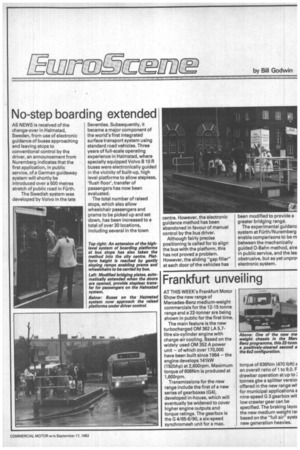No-step boarding extended
Page 41

If you've noticed an error in this article please click here to report it so we can fix it.
AS NEWS is received of the change-over in Halmstad, Sweden, from use of electronic guidance of buses approaching and leaving stops to conventional control by the driver, an announcement from Nuremberg indicates that the first application, in public service, of a German guideway system will shortly be introduced over a 500 metres stretch of public road in Furth.
The Swedish system was developed by Volvo in the late Seventies. Subsequently, it became a major component of the world's first integrated surface transport system using standard road vehicles. Three years of full-scale operating experience in Halmstad, where specially equipped Volvo B 10 R buses were electronically guided in the vicinity of built-up, high level platforms to allow stepless, 'flush floor', transfer of passengers has now been evaluated.
The total number of raised stops, which also allow wheelchair passengers and prams to be picked up and set down, has been increased to a total of over 30 locations, including several in the town Top right: An extension of the highlevel system of boarding platforms at bus stops has also taken the method into the city centre. Platform height is reached by gently sloping ramps enabling prams and wheelchairs to be carried by bus.
Left: Modified bridging plates, automatically extended when the doors are opened, provide stepless transfer for passengers on the Halmstad system.
Below: Buses on the Halmstad system now approach the raised platforms under driver control. centre. However, the electronic guidance method has been abandoned in favour of manual control by the bus driver.
Although fairly precise positioning is called for to align the bus with the platform, this has not proved a problem. However, the sliding "gap filler" at each door of the vehicles has been modified to provide a greater bridging range.
The experimental guidanc system at Furth/Nuremberg enable comparisons to be m between the mechanically guided O-Bahn method, alre in public service, and the les: obstrusive, but as yet unpro) electronic system.
































































































